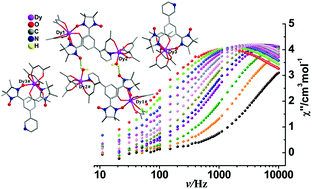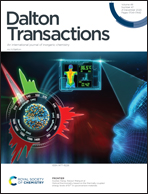Slow relaxation of magnetization in lanthanide–biradical complexes based on a functionalized nitronyl nitroxide biradical†
Abstract
Three novel lanthanide–biradical complexes {[Ln(hfac)3]2(mbisNITPyPh)(H2O)}{[Ln(hfac)3](mbisNITPyPh)}·CHCl3 (1-Gd; 2-Tb; 3-Dy) were successfully achieved by reacting the biradical mbisNITPyPh (5-(3-pyridyl)-1,3-bis(1-oxyl-3′-oxido-4′,4′,5′,5′-tetramethyl-4,5-hydro-1H-imidazol-2-yl)benzene) with Ln(hfac)3·2H2O (hfac = hexafluoroacetylacetonate). These Ln–biradical complexes consist of two kinds of spin moieties, namely, dinuclear {[Ln(hfac)3]2(mbisNITPyPh)(H2O)} and mononuclear {[Ln(hfac)3](mbisNITPyPh)}, in which two adjacent dinuclear units are linked by intermolecular hydrogen bonds involving the uncoordinated nitroxide units and the coordinated water molecules of Ln ions, forming a cyclic tetranuclear structure unit. The magnetization study reveals that intramolecular Ln(III)-coordinated NO ferromagnetic interactions are dominant in the present system. Moreover, the clear frequency dependence of ac magnetic susceptibilities of complex 3-Dy is indicative of slow relaxation of magnetization behavior, indicating its single-molecule magnet nature.



 Please wait while we load your content...
Please wait while we load your content...